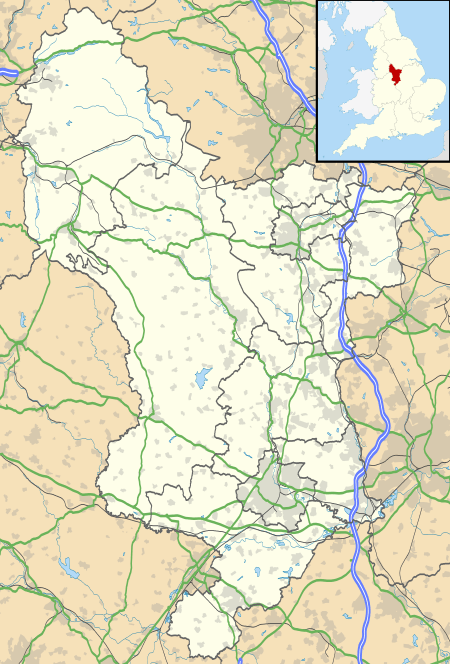Wyver
Wyver Lane Nature Reserve, also known as Wyver Lane Pool Reserve, lies west of the River Derwent and just north of Belper. The reserve lies on a nineteen-acre site and is part of the Derwent Valley Heritage Way. It is also placed on reoccurring flood plain which makes it an attractive place for wildlife, especially wading birds.
| Wyver | |
|---|---|
 Wyver Lane Nature Reserve | |
 Wyver Location within Derbyshire | |
| OS grid reference | SK342499 |
| District | |
| Shire county | |
| Region | |
| Country | England |
| Sovereign state | United Kingdom |
| Post town | BELPER |
| Postcode district | DE56 |
| Police | Derbyshire |
| Fire | Derbyshire |
| Ambulance | East Midlands |
Derbyshire Wildlife Trust leases the area from Amber Valley Borough Council and now manages it as a nature reserve and is one of Derbyshire’s most important wetland reserves.
To ensure that the many bird species continue to thrive there, there is no access onto the reserve. The reserve consists of two pools both surrounded by water meadows and reed beds. A huge variety of birds has been recorded there over the years.
History
When Belper Mill was originally built in the 1700s, they dammed the River Derwent to channel water to power the mill. They then raised the river bank north of the Mill where the reserve now stands to try and avoid the river overflowing. Despite this, the river breached many times forming several pools which you can see today.
In later years, the Territorials used the area for shooting practice. One can still see the old firing range at the bottom of the lane. Several buttresses are still visible. One is the island that is on the left-hand side of the main pool. One is barely visible on the right hand side of the main pool. Others have now almost disappeared. To the left of where the viewing mound stands is an old metal gate post. It was used by the Territorials. If there was a green flag on the gate it was safe to go through. If a red flag, then it wasn't. A little further down the lane there is a bricked up hut on the left hand side. This was the ammunition store. Because the Territorials didn't want water on the land they used to pump it into the river. The pump house is the brick building at the southern end of the reserve with the big pipe sticking out.
After the Territorials had finished using the land, the Amber Valley Council started using it as a tip. The big field that is in front of the viewing mound has all sorts of nasty things buried underneath it. In those days there weren’t any laws on what one could and couldn't dump. By burying thousands of tons of rubbish, it pushed any water that was there further up and this created bigger pools. A few local birders still sometimes pump out water into the river to keep the pools low to attract waders. As with most tips it used to be good for Gulls including visits from Iceland and Glaucous Gulls. Eventually the tip closed in the 1970s and things started to settle down. Levels are now controlled by a sluice at the southern end of the main pool. There is also a pipe that leads from the main pool to the river which is bunged during winter to maintain the water levels for wintering wildfowl. Then come spring it's taken out again and if we get a dry summer it should be low enough to attract waders late summer/autumn.
References
External links
- Wyver Lane - Derbyshire Wildlife Trust